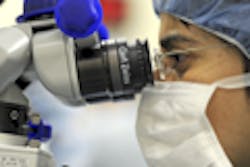The word “automation” typically conjures up a swirl of mental images of robots everywhere and all kinds of processes being accomplished without human involvement—but in fact, automation is usually less dramatic than that. The automation “revolution” has been and continues to be a steady adoption of automated procedures to do work that had traditionally been accomplished through human effort. The lab industry is a case in point; it has enjoyed a quiet, purposeful growth of automation in its workplace.
Changes in the practice of laboratory medicine are data-driven events. A lab does not put a new assay into clinical practice without robust supporting data, and extensions of laboratory automation are handled the same way. They are typically done out of a need for optimization around error reduction or an increase in throughput. These two guiding principles have driven the rise of automation in the laboratory.
So walk into a laboratory today and what do you see? Typically you see one of two things: either islands of automation around specific, high-volume regions of the laboratory (like clinical chemistry or hematology); or a single-vendor solution (either from an instrument maker or independent third party) that handles all of the high-volume instruments and also provides pre- and post-analytic handling. It’s impressive to look at how far the industry has come in a fairly short time. And given the continued pressures on the business of laboratory medicine (reimbursement challenges, staffing shortages), we know there is more that we can do to enable the laboratory of today to be able to serve the increased demands of the patient volume of tomorrow.
How we got here…
How did automation become an indispensable part of the clinical lab? It happened in three “waves.”
First, we automated the performance of the actual lab test. Remember, it was called a “hematology bench” or a “chemistry bench” for a reason — it was a real bench in the laboratory where the tests were performed by hand. But starting in the early 1950s with the AutoAnalyzer designed by Leonard Skeggs and the “Robot Chemist” invented by Hans Baruch, this first wave of automation began, which has led to the high-throughput, automated instruments we see in the core lab today. This first step into automation allowed laboratories to scale up from the limits of human hands directly doing the work.
Next, with automated instruments able to handle a growing volume of samples, the second wave of automation centered on moving work to and from the automated instruments via track systems, essentially conveyor belts for lab specimens. By providing an efficient way to move the samples to and from the instruments, the specimen demand of the automated instruments could be matched, and the throughput of the lab could climb even more.
Third, we automated the pre-analytic and post-analytic work that bookends the testing, specifically the preparation (centrifugation, aliquoting, etc.) and storage of the specimens in the laboratory. This focus on the beginning and the end of the life cycle of the specimen further sped up the flow of specimens through the lab while reducing error and variance at the same time by automating the repetitive tasks that laboratory staff had to perform.
In a modern laboratory today, you will see at least one if not all three of these waves of automation at play, driving a low-error, high-throughput workflow for lab testing. And given the present state of affairs in laboratory medicine, automation is no longer a nice-to-have, but rather a must-have, for the effective functioning of the laboratory.
Where we’re going…
But what is next in automation? What will the next wave look like?
First, there are still unautomated areas of the lab that the current economic and labor climates for laboratory medicine are now making suitable for automation, specifically microbiology and anatomic pathology. Over the past few years, advances have appeared in automated specimen handling and automated testing in microbiology that allow labs to scale the testing volume despite staffing challenges. In anatomic pathology, the recent FDA clearance of specific digital pathology systems is generating a need for increased specimen processing with consistent quality suitable for en masse digital slide scanning. Also, with the growth of outreach-based/clinic-based testing, small-scale automation for pre-analytic work in the clinic is now possible and desired. Imagine the specimen being accessioned and processed (sorted, centrifuged) before transport to the laboratory. By doing this, the laboratory can test the sample upon arrival without the upstream delays of pre-analytic processing. An “everything is ready upon arrival” paradigm allows the lab to run at top speed for every specimen and test, providing a significant boost to productivity.
Finally, an “in silico” type of automation is slowly appearing as well. While not mechanical in nature like the examples mentioned above, in silico automation or “laboratory artificial intelligence” (AI) is helping to automate the overall workflow and performance of the laboratory. The early signs of this automation are seen in various contexts, such as courier route optimization using geospatial mapping or appropriate test performance based on sample quality or collection requirements. Over time, the sophistication of this layer in between the performers of laboratory work (instruments, couriers, etc.) and the overall orchestrator and recorder of lab work (currently the laboratory information system) will grow and change from simple pipes that route orders and results to an actual layer of laboratory intelligence that monitors and optimizes the laboratory.
A key lesson in this continual march to a faster, more precise laboratory via automation is how smoothly the lab medicine industry has handled and will handle the changes from manual processes to automated ones. The reason is the open-minded approach the industry has taken, centering on making the task fit the automation, not the other way around. Instead of building a robotic medical technologist, the industry made track systems and automated instruments. When you scale something, you have to give up something to grow. With automation, the laboratory has given up human hands on the specimen containers and the actual performing of the tests to let the machines do it faster and with less error. And this has allowed laboratories to scale to handle the growing needs of the population. This next wave of automation will do the same thing, enabling laboratories to scale both the instruments that perform the tests and the people that drive the workflow.
REFERENCES
- Laboratory Diagnostic Machines. Science Museum Website. http://www.sciencemuseum.org.uk/broughttolife/techniques/labdiagnosticmachines.
- Hawker CD. Nonanalytic laboratory automation: a quarter century of progress. Clin Chem. 2017;63(6).
- Kelly K. The Inevitable: Understanding the 12 Technological Forces That Will Shape Our Future. New York: Viking Books. 2016.
John David Larkin Nolen, MD, PhD, MSPH, serves as Managing Director, Laboratory Business Unit, for Cerner Corporation.

